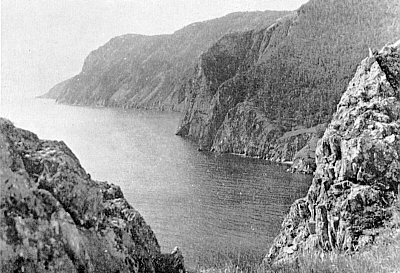QBARS - v24n4 Four Asiatic Rhododendrons
Four Asiatic Rhododendrons
By Vladimir Vasak CSc.,
Botanical Institute of Czechoslovak Academy of Sciences,
Pruhonice near Prague, Czechoslovakia
During the summers from 1966 until 1969, 1 worked as a member of botanic expeditions to Asia. In 1966 I was in Mongolia. During 1967 and 1969 I was in the environs of the Baical Lake and in 1968 I was on the Sakhalin and Kurile Islands. (Figs. 54 & 55.)
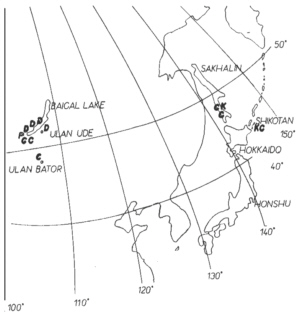
|
|
|||
|
Fig. 54. Localities where I collected
Rhododendron chrysanthum - C R. camtschaticum - K R. parvifolium - U Del. J. Balounová |
In the course of my traveling I collected four species of the genus Rhododendron: Rhododendron chrysanthum Pall., R. parvifolium Adams., R. dauricum L. and R. camtschaticum Pall.
I must say I often met the rare (in cultivation) species Rhododendron chrysanthum Pall. (synonyms: R. aureum Georgi, R. officinale Salisb.) of subgenus Eurhododendron, section Leiorhodium. The first time was 1966 in Mongolia below the summit of the mountain Asaralt Chairchan, at an altitude of 2.700 m, in the Chentei Mountains. It grew in the neighbourhood of snowfields on very cold sites. On the 8th of September I was on top of Asaralt Chairchan (chairchan in Mongolian=most beautiful). It was just the time, when the tops of Chentei Mountains were covered with the first snow and awaited the frost and ice. Although I collected some capsules, their seeds as they were not mature, did not germinate at all. Protected from the cold winds, in the typical alpine tundra, Rhododendron chrysanthum grew in association with willow - Salix nummularia , stonecrop - Rhodiola (Sedum) quadrifida , dryad - Dryas oxyodonta, Gentiana grandifolia and G. algida , cudweed - Gnaphalium supinum (a new species for Mongolia), saw-worts - Saussurea schanginiana and S. baicalensis .
In 1967 I saw an interesting formation of Rhododendron chrysanthum . It was not far off the shores of the Baical Lake at about 490 m elevation. This high-mountain Rhododendron species came down from the slopes and tops of the Chamar Daban Mountains, attracted by the moisture and coldness round the great lake and grew there on north slopes with another high-mountain shrub - Pines pumila (Pall.) Rgl. Its habit was quite different from the individuals in the mountains. The shrubs were more than 1 meter high and the leaves were large. I can say that from the imported seeds of these plants the young plants grow quite well. In the mountains of Chamar Daban where I traveled in 1969, I had an opportunity to see and visit the thickets of Gold Rhododendron. In the Siberian Cembra Pine ( Pinus Cembra L. var. sibirica Loud.) woods it formed shrub formations in some places. From my own experience I can say, that this rare and nice shrub, loved by so many rhododendron growers, also can be hostile when its dense growth prevents a plant hunter in his walking, intertwining his legs unmercifully with its distorted strong branches. It happened to me several times that I was quite its captive. But all these hardships I can forgive to Rhododendron chrysanthum if it will grow well and give pleasure to the grower. I collected Golden Rhododendron in 1968 on the Island of Sakhalin on Mt. Czechova at height of 1040 m, on the island Shikotan (Kurile islands) on Notoro (an extinct volcano 350 m) and on Mt. Shakotan (300 m). It was everywhere on the peaks of the mountains, in association with alpine plants. On the little island Shikotan the border of the alpine zone is very low due to the cold Kurile stream Oyashio.
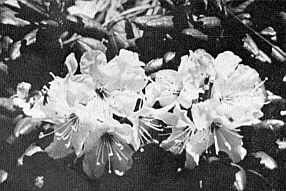
|
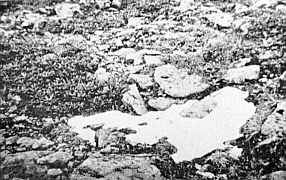
|
|
Fig. 56. The flowers of the Golden
Rhododendron; Sakhalin, Mount Czehova. Photo by E. Egorova |
Fig. 57.
Rhododendron chrysanthum
in
the Chentel Mountains below the top of the mountain Asaraltcharichan. Photo by author |
Rhododendron chrysanthum is an evergreen, hardy shrub, or a creeping shrublet with large leathery dark green leaves and big pale-yellow flowers. It belongs to a group of plants, preferring the rough mountain conditions more than the careful grower's care in the garden. It is successfully cultivated in Japan as bonsai. Takeda in his instruction draws the grower's attention to the fact, that Gold Rhododendron is very particular about moisture.
It grows on the large area from the Altai Mountains in West Siberia-over Mongolia-to Kamchatka, on Sakhalin, Kurile Islands and in the mountains in Japan and Korea. It is not only a decorative plant, but also a medicinal plant. (Vide its Latin name Rhododendron officinalis Salisb.) The decoction of its dried leaves has a diuretic effect, it cures diarrhoea and stimulates the heart. But its fresh leaves are poisonous and are seldom used in medicine as a dangerous abortivum. It is used also in cases of nervous disorder and rheumatism. With a decoction of Juniperus pseudosabina and Tanacetum boreale it cures sick kidneys. It has also bactericide properties and can be therefore used also in dental medicine, like sage. On the north frontier of Mongolia, in the Dzhidin Mountains, hunters use its withered brown leaves as a tea substitute (Malyshev). In the environs of Baical Lake its leaves are picked in quantity and delivered to the pharmaceutic industry.
In the Baical Lake zone it is well known by the name "kashkara", in Mongolia "chasylgana", on Kamchatka "katanyr", "pjanaja trava" (drunken herb), "korjackaja trava", in Japan as "Kibana-shakunage". As we see it, it is not only a nice little Rhododendron (one of the ten species named by Farrer as alpines), but also a useful shrub or shrublet - a source of medicaments.
Two hybrids are known: An early flowering hybrid with Rhododendron caucasicum and a Japanese hybrid with Rhododendron brachycarpum ( R. x nikomontanum Nakai). It is possible that because of its yellow flowers a rare Rhododendron hybrid will be obtained, and the hybrid will carry the hardiness of its progenitor, the Golden Rhododendron. Rhododendron chrysanthum is constant in its whole area, and little variable. Only on the island of Honshu, Japan, grows form senanense (Yabe) Hara with petaloid stamens (Ohwi). Rhododendron chrysanthum Pallas, should be named R. aureum Georgi (as it is mostly cited by the Russian authors), as Georgi described it earlier than Pallas (1775). But it is more known under Pallas' name. Golden Rhododendron appeared in cultivation in 1796, it is a typical mountain shrublet, difficult to grow in the lowlands.
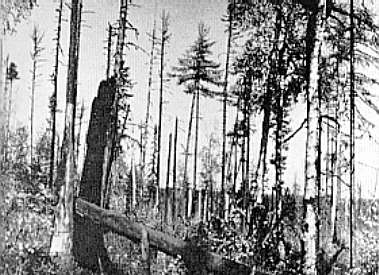
|
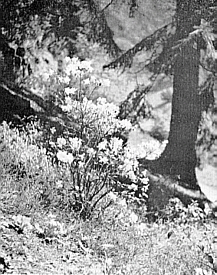
|
|
Fig. 58. A forest destroyed by fire in the environs of
Lake Baical - with an undergrowth consisting of predominately of Rhododendron dauricum . Photo by author |
Fig. 59.
Rhododendron
dauricum in the park of Pruhonice. Photo by H. Atanasovd |
The second species I collected was the Daurian Rhododendron - Rhododendron dauricum L. from the subgenus Eurhododendron, section Rhodorastrum. A rather great quantity of seeds of this species I brought to Czechoslovakia in 1967, 1968, and 1969. The seeds germinated very well and hundreds of plants have been planted out in various parks and gardens in Czechoslovakia. I collected them on the south-west coast of the Baical Lake, east of the Baical Lake, close to the town of Ulan - Ude in the promontory of Ulan Burgasy Mountains and on the Baical island Olchon.
In the environs of the Baical Lake, Rhododendron dauricum forms extensive thickets in the larch forests, in the bushes of Alnus fruticosa and mainly in the pine forests. In spring, when whole hillsides are covered with rosy purple blossoms of Daurian Rhododendron, the town inhabitants of this zone of Siberia come there to admire this natural beauty. I did not see these stands in full blossoms, as it was later in summer; I saw only some shrubs, flowering by single, secondary flowers. I collected the matured fruits with seeds.
On the island Olchon, on movable sand dunes, I saw an interesting view. In the dense, 20-30 cm high stands only one to two year twigs jutted out from the sand. As the two to three year old wood of the shrubs rooted, the movable sand did not destroy the shrubs of Rhododendron dauricum . This bears a proof of its resistance and vitality. Such shrubs, which are able to save their life in the dunes of movable sand, are not too many. The Daurian Rhododendron grew in a quite unusual neighborhood of the psammophilous Oxytropis lanata - the prettiest hairy Oxytropis in the environs of Baical - , wild progenitor of edible rhubarb - Rheum undulatum , and the yelllow poppy Popover baicalense , being the second time in flower that spring.
Now I should like to draw the reader's attention to the positive feature differentiating it from any other Rhododendron species. It often grows in its native country in the pine forests with very sparse wood humus. It can grow on mineral soils, as long as they have no alkaline reaction, without elaborate preparing of the "peaty bed" for planting.
Rhododendron dauricum is an important nectar plant, (in Czechoslovakia in March and April, at home, in the environs of the Baical Lake in May and June), much frequented by the honey-bees. The adult shrubs in our Botanical Garden at Pruhonice are covered with bees at flowering time. Its glandular leaves, give out a strong pleasant smell when rubbed. In the environs of the Baical Lake it is called "bagulnik". Its variant sempervirens Sims. in the Altai and West Saian Mountains is called "maralnik." This is a western variant of species with partly persistent leaves. It was described as Rhododendron ledebourii Pojark in 1952. Pojarkova described yet the other small species of the Rhododendron dauricum family, Rhododendron sichotense , from the eastern slopes of the Sichote-Alin Mountains. Judging by the Ohwi description, there belongs here also R. dauricum from the Japanese island Hokkaido. The similar Korean Rhododendron, Rhododendron mucronulatum Turcz. (syn. R. dauricum var. mucronulatum Maxim.), grows in Korea, in the adjacent small zone of the USSR, in northeast China and on the Japanese islands, Honshu and Kiushu. Korean Rhododendron and Dahurian Rhododendron are often confused, but one can reliably differentiate them by their dissimilar leaves. While the larger leaves of R. mucronulatum are acute, mucronulate, the leaves of R. dauricum are smaller and blunt, obtuse.
Koropacinskij and Skvorcova mention the using of R. dauricum var. sempervirens as a medicinal plant. They remark also that this shrub, growing and luxuriantly flowering in Tuva in the mountains at a height of 1400-1800 m. seldom has viable seeds. I had a similar experience for in 1967 R. dauricum had plenty of seeds, yet in 1969 in the environs of the village Gurulba, not far from the town Ulan Ude, I found fertile shrubs only on the slopes.
As I have already mentioned, Rhododendron dauricum is one of the species which is quite easy to cultivate. Also its seeds germinate very well. In the first year the seeds germinated 100%, the two-year-old seeds germinated 70-80%. It has been under garden cultivation since 1780. I should like to offer seedling plants to Rhododendron growers interested in the exotic original plants, provided that they send the requested phytoquarantine permit to my address. And now - what does Rhododendron dauricum in fact look like?
It is a shrub, growing up to 2 m height, with a light-gray bark, deciduous leaves, and single, but numerous rosy-purple blossoms. It flowers early, before the leaves and covers itself with blossoms. In England it flowers as early as January, in more severe climate it flowers later, usually just after the snow-thaw. It happens sometimes that during flowering the snow is falling and then this first herald of spring is exceedingly beautiful and welcome.
In 1968, I saw Rhododendron camtschaticum Pall. seven times in its natural habitat. Three times I saw it on the island Sakhalin - once on the top of Mount Czechova, 1040 m a. s. 1. and twice on the top of Mount Zhdanko (in Japanese Tosso), 700 m a. s. 1. Four times I saw the Kamchatka Rhododendron on the small island of Shikotan. That was on the coastal rockeries of the Matokutan (Otriadnoie) Bay and on "Mys Krai Sveta"-Finis terrae Cape, on the top of the extinct volcano Notoro and on the hill of Shakotan. In all these cases it was sheltered in crevices among the stones. It did not occur in quantity anywhere and only on a few places was it fertile. I must say that its seeds, which we have sown, germinate rather badly - this agrees with the experiences of some gardeners and dendrologists.
As I had no opportunity to see it flowering (I possess only its slide which I received from the Sakhalin botanist, Mrs. E. Egorova) - I take the liberty to use the quotation from Farrer: "It is minutely dwarf, with broad hairy deciduous leaves of pale green, and half-nodding large singly-borne flowers, flat and wide, of deep satiny claret-purple...It flowers late, in June and July, it appears in cultivation as early as in the year 1800, but it is cultivated in alpine rock gardens only very rarely.
The germinative capacity of seeds from my collection was very low - only about 10%, and I am constantly worrying about the fate of the seedlings. The mature plants could be propagated by cuttings, but it is not an easy method of increase. In my opinion, this is the reason why Rhododendron camtschaticum is only a rare guest in gardens.
As a typical north-pacific plant, it grows on the coast rockeries and in the highlands of the eastern coast of the USSR, on Kamchatka, Sakhalin, Kurile Islands, on the Japanese island Hokkaido, and on the Mountain Iwate on Honshu Island on Aleutian islands and in Alaska. In nature, it is little variable. On Hokkaido grows a very glandular hairy variety barbatum (Nakai) Tatew., on Kamchatka subsp. intercedens Hult., and on Kodiac Island appears a rare, white flowering form (Hulten).
And now I should like to mention some of the companion plants of Rhododendron camtschaticum on Sakhalin: alp-lily - Lloydia serotina stonecrops - Sedum roseum, S. pluricaule ; crowberry - Empetrum asiaticum , Streptopus streptopoides, Rubus pedatus , service tree - Sorbus sambucifolia , Eritrichium sachalinense ; starwort - Aster dubius, Sieversia pentapetala ; resurrection plant - Selaginella sibirica ; Hawk's beard - Crepis hokkaidoensis, Hedysarum sachalinense, Patrinia sibirica , Minuartia arctica ; bell-flower - Campanula dasyantha, Pinus pumila , speedwell - Veronica , schmidtiana , Diapensia obovata ; lion's foot - Leontopodium discolor . On the Kurile island of Shikotan in addition to the Sakhalin species there were: rockfoil - Saxifraga funstonii , ladybell - Adenophora kurilensis ; smooth lungwort - Mertensia pterocarpa ; primrose - Primula matsumurae , Hedysarum komarovii ; rockbrake - Cryptogramme crispa , Arnica unalsehkensis ; worm-wood - Artemisia schmidtiana , Oxytropis retusa , Leontopodium kurilense , Parageum calthifolium , Sedum kurilense , Arctous japonica , Rofieldia nutans ; cinquefoils - Potentilla matsumurae and P. diekinsii . Almost all of them are very nice and mostly rare species, and as for their appearance, adequate companions of Rhododendron camtschaticum .
It may be of interest that Rhododendron chrysanthum grew on both Sakhalin and Shikotan in similar habitats. There was only one difference here: while Rhododendron camtschaticum came down to the coast slopes, Rhododendron chrysanthum always grew only on the tops and in rocks of the hills.
The fourth Rhododendron species I met personally in Asia was Rhododendron parvifolium Adams - which I should rather call by its synonym Rhododendron palustre Turcz., and I saw some of its "sterile" shrubs on the peaty moorland not far away from the village of Tibilti between the Tunkin Alpes and the Chamar Daban Mountains. It grew there together with the rather scarcely occurring spruce with blue needles - Picea obovata var. coerulea , a bushy birch not determined yet, and Potentilla fruticosa . This small-leaved rhododendron also grows on the tops of mountains. While this mountain variey is about 20 - 50 cm high, the lowland variety used to be about 100 - 120 cm high. It is widespread in the zone of the Saian Mountains, in Middle Siberia - across the northern parts of Mongolia, north-east China, north Korea, Sakhalin, Hokkaido (north Japan) - up to the Aleutian islands and Alaska. Its whole thickets are often "sterile", without blossoms. This phenomenon appears in nature very often: Many under the severe climatic conditions of their home seldom flower, as if they saved their strength for the struggle with natural elements. In cultivation to the contrary, they surprise us with their regular flowering. I must remark, however that also opposite cases occur, but these mostly concern the sensitive little rock plants.
In the course of four years, in four botanical expeditions (or excursions) I saw only four Rhododendron species. To tell the truth it is not too much, but considering that I moved along the north border of the Rhododendron family's distribution area, I am quite satisfied with this result. In the year 1970 I intend to go as a member of a botanical expedition to Korea or to the Caucasus. I hope to have good luck and to find other species in the local forests. And in this case I shall not forget to let you know my new impressions.
BIBLIOGRAPHY
- Grubov V. I. (1955): Konspekt flory Mon-golskoj narodnoj respubliki.
- Hulten E. (1968): Flora of Alaska. Koropacinskij, I. J., Skvorcova, A. V. (1966): Derevja i kustarniki Tuvinskoj ASSR. Malysev, L. I. (1965): Vysokogornaja flora vostocnogo Sajana.
- Malysev, L. 1. (1965): Opredelitel vysokogornych rastenii juznoi Sibiri.
- Ohwi, J. (1955): Flora of Japan.
- Poletiko, O. M. (1960): Vereskovyje - Ericaceae DC. In Derevja i kustarniki SSSR V. Rehder, A. (1962): Manual of Cultivated Trees and Shrubs.
- Takeda H. (1938): Alpine Flowers of Japan.
